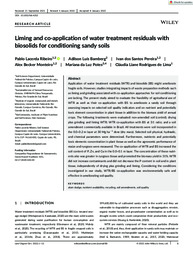Liming and co-application of water treatment residuals with biosolids for conditioning sandy soils.
Liming and co-application of water treatment residuals with biosolids for conditioning sandy soils.
Author(s): RIBEIRO, P. L.; BAMBERG, A. L.; PEREIRA, I. dos S.; MONTEIRO, A. B.; POTES, M. da L.; LIMA, C. L. R. de
Summary: Application of water treatment residuals (WTR) and biosolids (BS) might ameliorate fragile soils. However, studies integrating impacts of waste preparation methods such as liming and grinding associated with co-application approaches for soil conditioning are lacking. The present study aimed to evaluate the feasibility of agricultural use of WTR as well as their co-application with BS to ameliorate a sandy soil through assessing impacts on selected soil quality indicators and on nutrient and potentially toxic element concentration in plant tissue in addition to the biomass yield of annual crops. The following treatments were evaluated: non-amended soil (control); drying plus grinding and liming WTR; WTR co-application with BS at 3:1 ratio; and a soil amendment commercially available in Brazil. All treatments were soil incorporated in the 0.0?0.2 m layer at 30 Mg ha1 dose (dry mass). Selected soil physical, hydraulic, and chemical parameters were determined. Furthermore, nutrients and potentially toxic elements concentration in plant tissue as well as the agronomic performance of maize and ryegrass were measured. The co-application of WTR and BS increased the soil content of P, Zn, and Cu in the 0.0?0.1 m layer. The concentration of these nutrients also was greater in ryegrass tissue and promoted the biomass yield in 51%. WTR did not increase contaminants and did not decrease the P content in soil and in plant tissue, independently of drying plus grinding and liming. Considering the conditions investigated in our study, WTR/BS co-application was environmentally safe and effective in ameliorating soil quality.
Publication year: 2022
Types of publication: Journal article
Keywords: Solo Arenoso, Tratamento da Água, Água
Observation
Some of Embrapa's publications are published as ePub files. To read them, use or download one of the following free software options to your computer or mobile device. Android: Google Play Books; IOS: iBooks; Windows and Linux: Calibre.
Access other publications
Access the Agricultural Research Database (BDPA) to consult Embrapa's full library collection and records.
Visit Embrapa Bookstore to purchase books and other publications sold by Embrapa.

